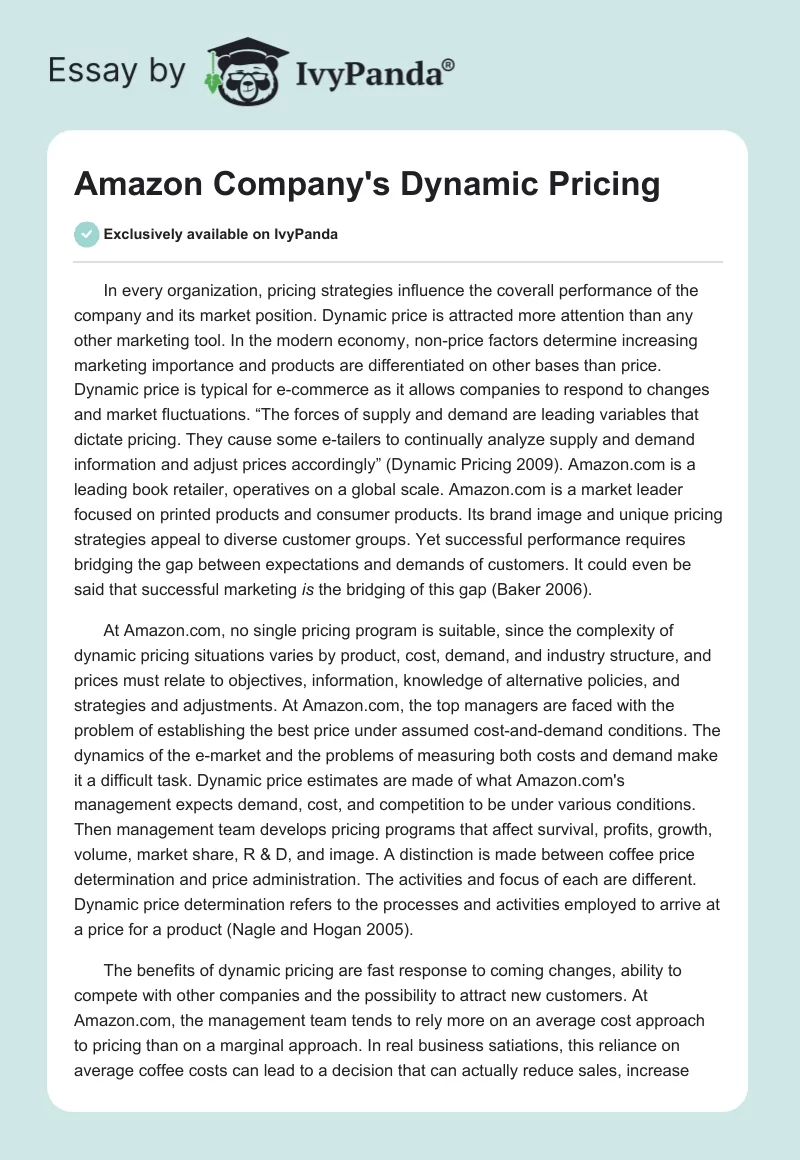In every organization, pricing strategies influence the coverall performance of the company and its market position. Dynamic price is attracted more attention than any other marketing tool. In the modern economy, non-price factors determine increasing marketing importance and products are differentiated on other bases than price. Dynamic price is typical for e-commerce as it allows companies to respond to changes and market fluctuations. “The forces of supply and demand are leading variables that dictate pricing. They cause some e-tailers to continually analyze supply and demand information and adjust prices accordingly” (Dynamic Pricing 2009). Amazon.com is a leading book retailer, operatives on a global scale. Amazon.com is a market leader focused on printed products and consumer products. Its brand image and unique pricing strategies appeal to diverse customer groups. Yet successful performance requires bridging the gap between expectations and demands of customers. It could even be said that successful marketing is the bridging of this gap (Baker 2006).
At Amazon.com, no single pricing program is suitable, since the complexity of dynamic pricing situations varies by product, cost, demand, and industry structure, and prices must relate to objectives, information, knowledge of alternative policies, and strategies and adjustments. At Amazon.com, the top managers are faced with the problem of establishing the best price under assumed cost-and-demand conditions. The dynamics of the e-market and the problems of measuring both costs and demand make it a difficult task. Dynamic price estimates are made of what Amazon.com’s management expects demand, cost, and competition to be under various conditions. Then management team develops pricing programs that affect survival, profits, growth, volume, market share, R & D, and image. A distinction is made between coffee price determination and price administration. The activities and focus of each are different. Dynamic price determination refers to the processes and activities employed to arrive at a price for a product (Nagle and Hogan 2005).
The benefits of dynamic pricing are fast response to coming changes, ability to compete with other companies and the possibility to attract new customers. At Amazon.com, the management team tends to rely more on an average cost approach to pricing than on a marginal approach. In real business satiations, this reliance on average coffee costs can lead to a decision that can actually reduce sales, increase costs, and reduce profits (Monroe, 2001). Though, some executives advocate that sunk costs (costs that cannot be revoked and that are not part of the current pricing decision) should be ignored. At Amazon.com, dynamic pricing strategies are not affected by current decisions — nothing can be done about them. The drawbacks of dynamic pricing include a need to monitor and evaluate market changes and predict possible fluctuations on long-term and short-term basis. This seems to make sense, because the concept introduces the notion of economies of scale and the impact of ability on costs, indicating that product volume beyond a certain point may increase costs. In formulating a marketing strategy for coffee beans, Amazon.com has dealt with only the broader relationships of pricing to selected elements in the marketing. Dynamic price decisions in specific situations require both experience and practical knowledge. Price theory alone will not suffice. In fact, where pricing is of critical concern, pricing specialists become necessary (Marn et al 2004).
In sum, dynamic pricing strategies of Amazon.com suggest that among the present and future external issues that influence pricing policy are the number and concentration of competitors, the degree of competition, profitability, ease of entry, product heterogeneity, size, legal aspects, channels of distribution, the elasticity of demand, total industry demand, kind and size of buyers, and spatial forces. Usually, these are handled through consideration of the anticipated cost-revenue approach.
References
Baker, R. J. (2006). Pricing on Purpose: Creating and Capturing Value. Wiley.
Marn, M et al (2004), The Price Advantage. Wiley; 1 edition.
Monroe, K. B. (2001), Pricing: Making Profitable Decisions. New York: McGraw-Hill.
Nagle, Th. T. Hogan, J. (2005). Strategy and Tactics of Pricing: A Guide to Growing More Profitably. Prentice Hall; 4 edition.
Pricing – Dynamic Pricing. (2009). Web.


